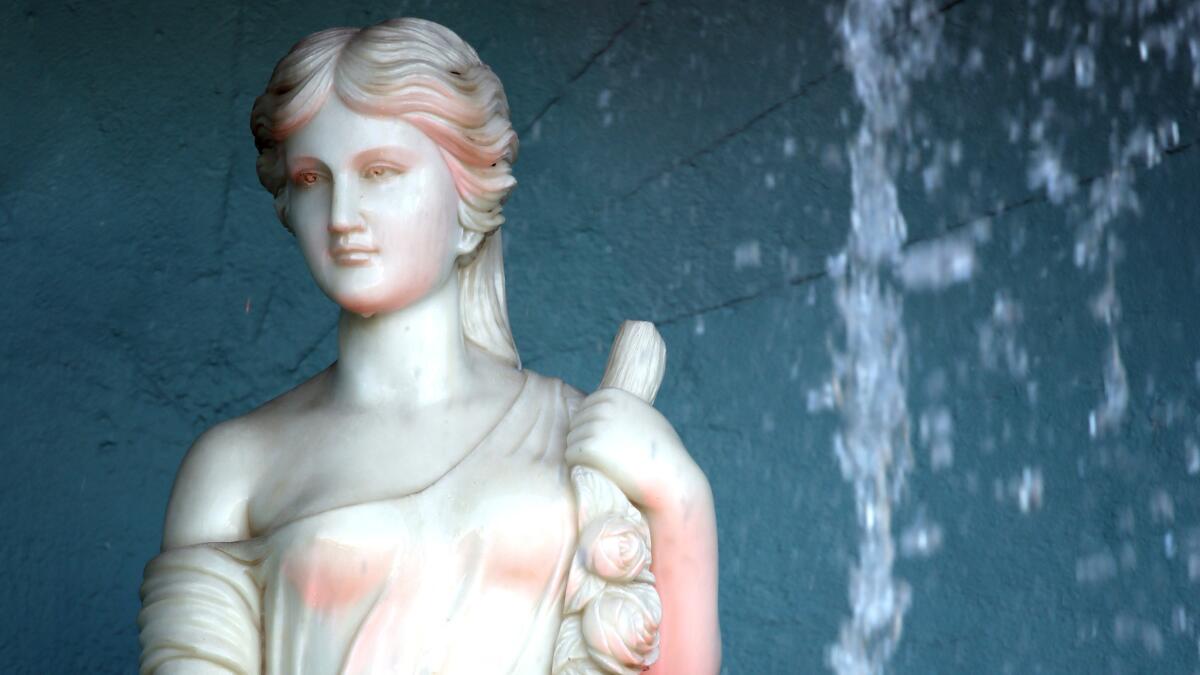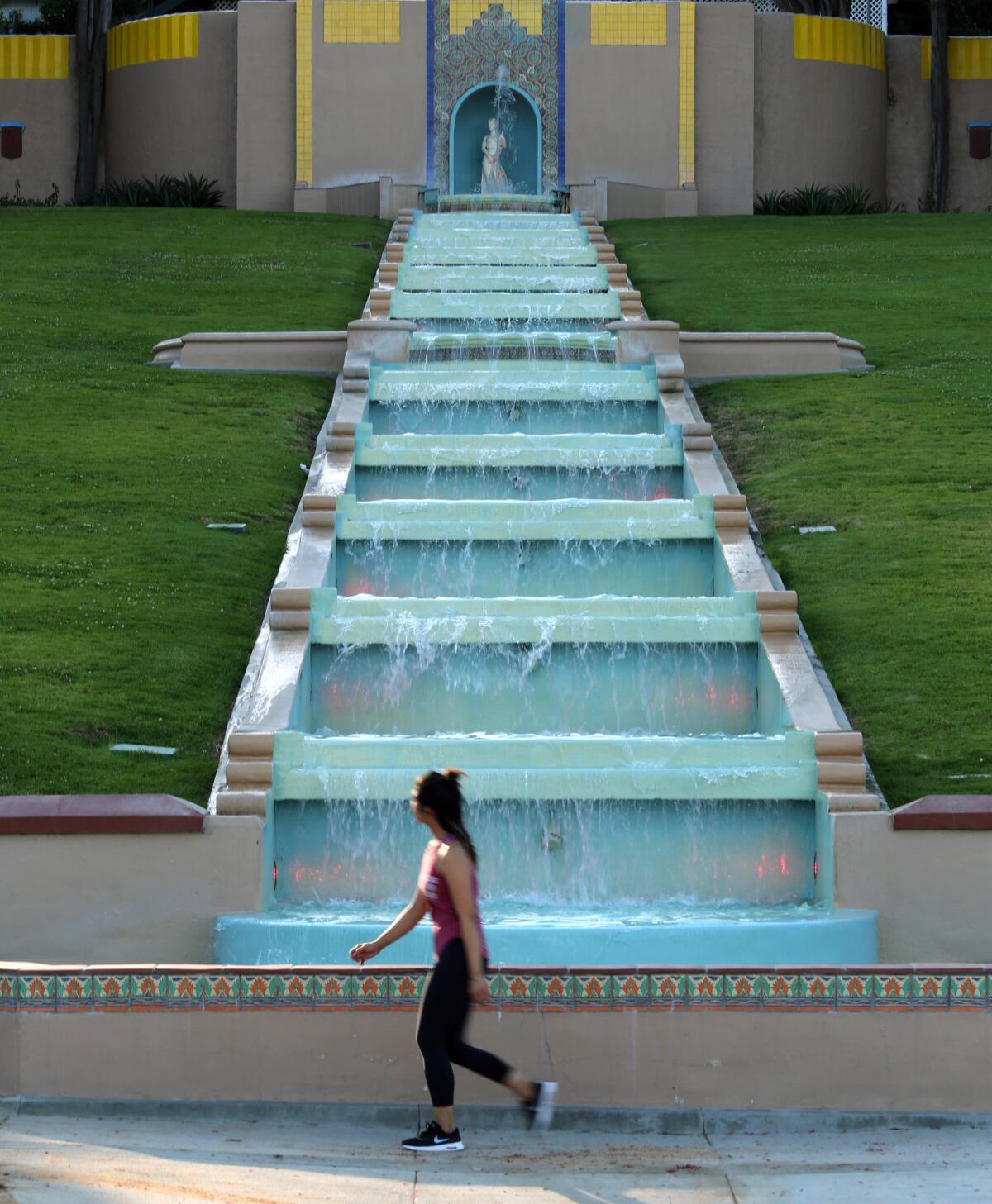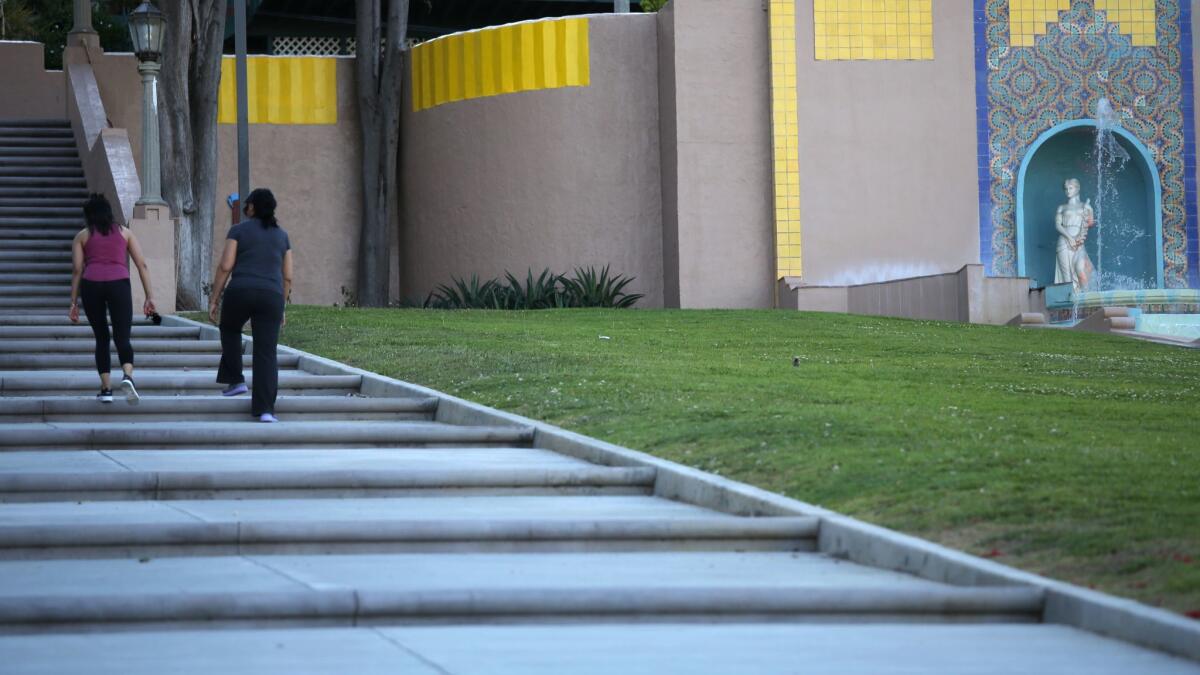A proposed statue with a Chinese face sparks resistance and debate in Monterey Park

How you feel about Monterey Park’s Cascades Park fountain depends on who you are.
To some longtime residents, the multi-tiered waterfall and the Athena statue that tops it are nostalgic reminders of the city’s past, when a Greek developer named Peter Snyder decided to build Midwick View Estates, a 1920s luxury community of Spanish- and Mediterranean-style homes, to rival Beverly Hills or Bel-Air.
For younger Latino and Asian residents, the fountain is mostly a beautiful backdrop to selfies, quinceaneras and weddings.
But few of them are aware that the fountain was the centerpiece to a housing development with an ugly side: Midwick View Estates was meant for whites only.
If we support you, none of us will be reelected.
— Monterey Park City Councilman Stephen Lam
The founders of Equitable Vitrines, an arts nonprofit, proposed temporarily placing a Chinese artist’s statue of biblical Eve with a Chinese face near the Athena statue.
Backers see the sculpture as a commentary on the housing development’s racist origins and celebration of the city’s more diverse present — it’s now 63% Asian and 30% Latino, according census figures — and future.
But a group of residents collected more than 100 signatures opposing the proposed project, and on Wednesday the City Council rejected it unanimously.
The proposed statue, by artist Xu Wang, used stone from the same quarry in China as the current Athena statue. Wang gave his Eve the face of a worker at the factory where the Athena statue was made.
“We can’t change history just to make people feel good,” said Nancy Arcuri, a longtime resident. “Should we tear down the Washington Monument because he owned slaves?”
Monterey Park is the latest community to grapple with a racist legacy.
Many of the state’s subdivisions were once governed by restrictive racial covenants designed to enforce segregation. They proliferated in the years after World War I as blacks began migrating in large numbers from the South to jobs in the North and West. But they were also used to keep people of other racial groups out of certain neighborhoods.
The covenants were private contracts between homeowners enforced by the court system. Owners who sold their house to a black family, for example, could be sued for damages by other homeowners in the neighborhood. In 1948, the U.S. Supreme Court ruled in Shelley vs. Kraemer that covenants were unenforceable.
Many Los Angeles County cities founded with the restrictions are now largely non-white. But they have remained an issue of pain and controversy. A decade ago, there was an effort by state officials to remove the written covenant from the public record.
An ethnic, working-class face depicted in a city park would be a meaningful nod to Monterey Park’s diversity, said Randall Avila, a city parks commissioner who voted to send the proposal to the council in January.
Art professors and curators from the L.A. County Museum of Art and Museum of Contemporary Art wrote letters supporting the project and saying they would use it to teach, and local critics promised to write about the piece.
It would offer the city a “subtle, though thought-provoking critique of our society’s assumptions about beauty, originality, and the processes by which art (and other products) are produced and brought into our lives,” wrote Matt Connolly, the nonprofit’s cofounder.
Sara Chao, a young Chinese Filipino artist, said the proposed statue would provide a much-needed representation of Asian female faces.

The lofty language had little effect on some longtime residents.
“Some cockamamie idea from people from West L.A.,” said David Barron, a former city clerk. He said the discussion of diversity the statue is trying to provoke is unnecessary.
“Here we’ve been able to work together, live together, and they want to split us up,” Barron said. “We solved all that stuff 25 years ago.”
Arcuri said she feels the same way about the fountain as some in the South do about the Confederate flag. The fountain is on the city seal and part of Monterey Park’s identity, she said.
At the council meeting Wednesday night, support and opposition to the project broke along generational lines.
Sara Chao, a young Chinese Filipino artist who grew up in Monterey Park, said the proposed statue would provide a much-needed representation of Asian female faces in public art.
Theresa Amador, another former city clerk, called the proposed statue “damaging” and “disturbing.”
Danny Woo, a teacher and resident, said the statue would represent “where we are and where we’re heading as a city.”
Paul Perez, a resident of Monterey Park since the 1960s, compared it to painting Bugs Bunny on the Mona Lisa to create a tourist attraction.
In the end, politics helped kill the project.
Councilman Stephen Lam said he voted against it because he didn't think most local residents supported it.
“If we support you, none of us will be reelected next term,” he said.
City leaders also weighed in with their own definitions of art. Mayor Teresa Real Sebastian said she felt that true art “doesn’t have an ethnicity.”
The Athena statue, she said, is an important reminder of home.
“For those who came here to say they want art that looks like you, you’re missing the point,” she said.
The council asked Equitable Vitrines to consider other locations for the statue, but the nonprofit withdrew the proposal, saying the commentary it offered was meaningless without the fountain’s location.
The debate has also uncovered another uncomfortable historical wrinkle: The fountain’s statue, art experts say, doesn’t depict Athena, who is usually shown with a spear, a helmet and other military symbols. The statue more likely depicts Flora, a Roman deity who represents spring and fertility.
“Athena is a military goddess, and there’s pretty much nothing military about this,” said Ann Marie Yasin, a classics professor at USC, though she can’t discount the possibility that the current statue is an artistic interpretation.
The current statue is actually a replacement installed by the Monterey Park Historical Society in 2005 after the original was stolen decades ago. Jim Iwaki, treasurer of the historical society, said he wasn’t sure whether there was a mixup.
Some cockamamie idea from people from West LA.
— David Barron, former Monterey Park city clerk

“I’ve always thought of it as Athena. I could be wrong,” Iwaki said.
But in the end what goddess the statue depicts doesn’t matter, said Ellie Lee, cofounder of Equitable Vitrines. And neither does the council’s decision.
The project sparked a wide-ranging debate about the definition of art and how to reconcile controversial histories with modern politics. And Monterey Park city leaders say that has inspired them to bring public art to other parts of the city.
“The conversation is all part of the art,” Lee said.
Twitter: @frankshyong
ALSO
In a California farm town, the border is just a line that must be crossed every day
Boy, 5, still missing after search of South Pasadena park where his father was found passed out
UPDATES:
3:03 p.m.: This article has been updated with additional information about the history of restrictive covenants.
Sign up for Essential California
The most important California stories and recommendations in your inbox every morning.
You may occasionally receive promotional content from the Los Angeles Times.







